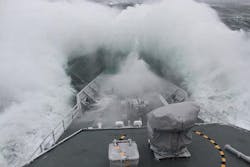DARPA eyes networks of intelligent floats to provide persistent wide-area ocean sensor coverage
Officials of the U.S. Defense Advanced Research Projects Agency (DARPA) in Arlington, Va., issued a special notice Wednesday (DARPA-SN-18-14) for the Ocean of Things program proposers day, which will be from 8 a.m. to 12:30 p.m. on Thursday 4 Jan. 2017 at the DARPA Conference Center, 675 N. Randolph St., in Arlington, Va.
The Ocean of Things program will provide persistent wide-area sensor coverage across the maritime environment with large numbers of intelligent floats.
Today's naval and commercial ships typically can use only their onboard sensors for situational awareness. Using remote sensors from aircraft and satellites can be limited or impossible because of fog, rain, cloud cover, and other environmental conditions. The DARPA Ocean of Things program will seek to correct these shortcomings, as well as provide ocean data to anyone who needs it.
Floats in the Ocean of Things program will rely on commercial hardware to generate data autonomously and in real time in a low-cost approach that could enable industry to build large numbers of floats to cover large operating areas and provide data from areas where limited visibility exists today.
Each onboard sensor mode will require research into efficient signal processing to conserve limited communications bandwidth and stored energy on a float, while making the most of information available from advanced analytic techniques.
The smart float system in the Ocean of Things program will use a cloud-based architecture, find ways to visualize the dynamic capabilities of the system, and find new ways for operators to interact with large numbers of floats.
Ocean of Things will deliver distributed ocean awareness to improve environmental characterization and support testing of specialized payloads and sensor behaviors to interact with surroundings and improve system performance.
Those interested in attending the Ocean of Things industry briefings should register on line at https://darpa.solers.com/oot/registration.php no later than noon eastern time on 27 Dec. 2017.
Email questions or concerns to John Waterston, the DARPA Ocean of Things program manager, at [email protected]. More information is online at https://www.fbo.gov/spg/ODA/DARPA/CMO/DARPA-SN-18-14/listing.html.
Ready to make a purchase? Search the Military & Aerospace Electronics Buyer's Guide for companies, new products, press releases, and videos
